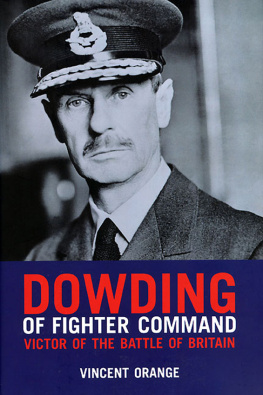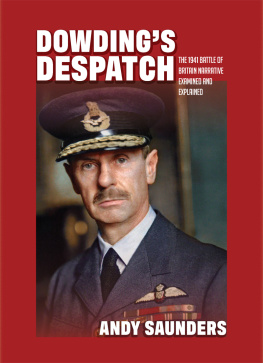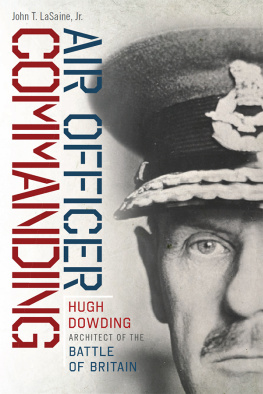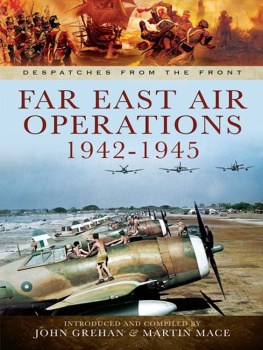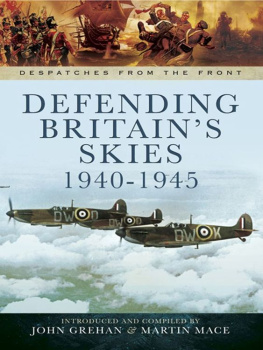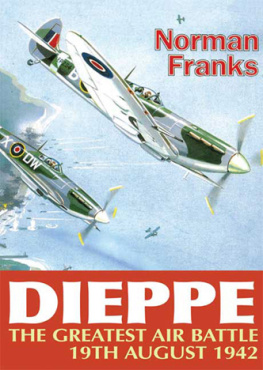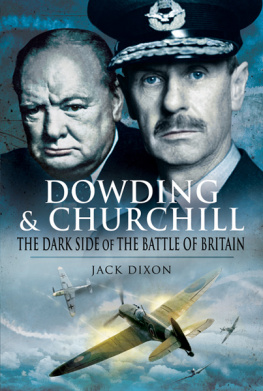AIR MARSHAL SIR KEITH PARK
My thanks to Wendy Rowlands, to whom the completion of this book owes much
AIR MARSHAL SIR KEITH PARK
VICTOR OF THE BATTLE OF BRITAIN, DEFENDER OF MALTA
MURRAY ROWLANDS
First published in Great Britain in 2021 by
PEN AND SWORD AVIATION
An imprint of
Pen & Sword Books Limited
Yorkshire Philadelphia
Copyright Murray Rowlands, 2021
ISBN 978 1 52676 790 5
ePUB ISBN 978 1 52676 791 2
Mobi ISBN 978 1 52676 792 9
The right of Murray Rowlands to be identified as Author of this work has been asserted by him in accordance with the Copyright, Designs and Patents Act 1988.
A CIP catalogue record for this book is available from the British Library.
All rights reserved. No part of this book may be reproduced or transmitted in any form or by any means, electronic or mechanical including photocopying, recording or by any information storage and retrieval system, without permission from the Publisher in writing.
Pen & Sword Books Limited incorporates the imprints of Atlas, Archaeology, Aviation, Discovery, Family History, Fiction, History, Maritime, Military, Military Classics, Politics, Select, Transport, True Crime, Air World, Frontline Publishing, Leo Cooper, Remember When, Seaforth Publishing, The Praetorian Press, Wharncliffe Local History, Wharncliffe Transport, Wharncliffe True Crime and White Owl.
For a complete list of Pen & Sword titles please contact
PEN & SWORD BOOKS LIMITED
47 Church Street, Barnsley, South Yorkshire S70 2AS, United Kingdom
E-mail:
Website: www.pen-and-sword.co.uk
Or
PEN AND SWORD BOOKS
1950 Lawrence Rd, Havertown, PA 19083, USA
E-mail:
Website: www.penandswordbooks.com
Foreword
Air Chief Marshal Sir Keith Park is one of New Zealands greatest military leaders. Murray Rowlands thoughtful biography, Air Marshal Sir Keith Park , will introduce a new generation of readers to an outstanding commander who played an absolutely central role in winning the Battle of Britain in 1940.
This biography contains significant new information and insights into both Parks professional career and his personal life. He was a remarkably self-contained man with great reserves of inner strength and willpower. These traits helped him through professional crises as well as personal tragedies.
Keith Park was a very modern commander who fully appreciated how all elements of an armed force must work effectively together to produce optimal outcomes. Throughout his military career, which saw him leave New Zealand in 1915 as a Corporal in the New Zealand Expeditionary Force and return in 1948 as a much decorated retired Air Chief Marshal, Park remained an undemonstrative, modest man who led by example. He respected all those with ability, loyalty and a willingness to work hard. He had, however, no time for the lax or incompetent, especially those who failed the men and women under their command. Park was, as Murray Rowlands points out, at his best in war. In crisis after crisis during the Second World War he displayed leadership of the highest order. Keith Park had a great ability to analyse complex problems and then work out and implement successful responses.
During the Second World War few individuals did more than Sir Keith Park to defend and uphold the values of freedom and justice that lie at the heart of the national psyche of both the United Kingdom and New Zealand. Murray Rowlands Air Marshal Sir Keith Park makes this clear and sets out the debt we owe him.
Kevin Short, Air Marshal
Chief of Defence Force
Wellington
NEW ZEALAND
August 2020
Preface
When Sir Keith Parks name is mentioned in relation to the Battle of Britain it is more often than not greeted with a blank stare. This is despite the fact that in 2009 after a campaign a statue was raised to him in Central London.
It is now eleven years since this happened, and the 80th anniversary of the Battle of Britain is with us. Publications now recognise Park as being the architect of victory and yet the memory of his contribution seems to have faded. I hope my book will remedy this.
Vincent Oranges biography of Park was published in 1984 and could not benefit from a whole range of historians reappraisals of events which happened during those months in 1940. Nevertheless Dr Orange has acted as a crucial pathfinder through the course of Parks life. I am also indebted to Christer Bergstrm for providing a clear picture of what the Luftwaffe was doing as it prepared its attacks on Britain. His book provides balance to the picture of the conflict in the skies of Britain.
I was very fortunate to be able to draw on the extensive collection of books on aircraft at Farnborough Library and the guidance and help I received from library staff. Thanks also to the staff at the Imperial War Museum and the Wigram Museum in Christchurch New Zealand
This is a political story which crosses eighty years and covers the treatment of Dowding and Park at the moment of victory in November 1940. Those who conspired in this shoddy act operated in the shadow of two great men.
Murray Rowlands
Chapter 1
Starting from the Lowest Level
It would require a feat of the imagination to conceive of a less propitious background for a man who would be the genius behind the first victory for the Allies in the Second World War.
In 1867 Europeans were drawn to a beautiful part of the North Island of New Zealand, south of Auckland, by the discovery of gold in the Kuranui Stream on the Coromandel Peninsula. The resulting gold rush resulted in the creation of the town of Thames which was an amalgam of two settlements, Grahamstown and Shortland, which became known as the Shotover and produced 102,353 ounces of bullion in its lifetime. In the period 1868 to 1871 the Thames mines officially produced 2,327,619 ounces of gold, which would today be worth US$3,000 million.
It was not gold that first brought John Livingstone Park to New Zealand. Like so many of the original settlers arriving in the country his first venture was into sheep farming. This was despite having originally moved from his home town of Aberdeen to study mining at the Royal School of Mines in London. Combining an interest in mountaineering and geology, in 1889 he became Director of the Thames School of Mines relegating climbing to a leisure activity. He had married Frances Rogers in Wellington and they were to have ten children: seven daughters and three boys. Keith, born in 1892, was the ninth child. His earliest memories were of the giant machines crushing the ore to remove its gold. The family lived in Totara just south of Thames in a two-storey building on the Thames side of the local cemetery overlooking the Kauaeranga valley. Keith attended a number of schools in the town, one of which was Tararu just north of the town.


